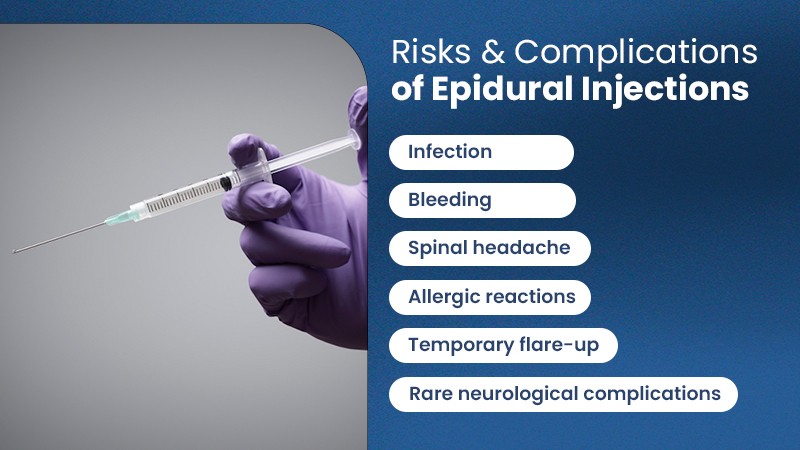How Much Does an Epidural Injection Cost?

How much is an Epidural Injection with and Without Insurance?
An epidural injection can cost ranges from $100 to $1000. It is important to remember that this is only an estimate and that actual expenses may differ on the basis of the previously listed criteria.
Fortunately, many health insurance plans cover epidural injections, either partially or fully. To learn more about your specific policy, it’s crucial to contact your insurance provider and inquire about the following:
- Does your plan cover epidural steroid injections?
- What is the pre-authorization process?
- Are there any co-pays, deductibles, or coinsurance associated with the procedure?
- Is there a preferred network of providers for epidural injections?
You can estimate your out-of-pocket expenses and choose your course of treatment with greater knowledge if you are aware of your insurance coverage.
Price Range for Epidural Injections
The following price ranges are estimates and can vary significantly on the basis of location, healthcare provider, insurance coverage, and other factors. For precise cost information, it’s imperative that you get in touch with your healthcare provider and insurance company.
- Single injection: $500 to $1,500 or more
- Multiple injections: $2,000 to $4,000 or more
Epidural Injection Cost With Insurance
The price with insurance will vary depending on your particular plan, but in general, you should budget for the following:
- Deductible: A set amount you have to pay before insurance coverage begins;
- Co-pay: $20 to $50 for every injection;
- Coinsurance: A portion of the whole cost.
Important Note: Even with insurance, you may still incur significant out-of-pocket costs, especially if you require multiple injections or if your insurance plan has high deductibles or coinsurance.
Understanding the Cost of an Epidural Injection
How much does an epidural injection cost is a common question for individuals experiencing chronic back or neck pain. A corticosteroid drug is injected into the epidural area surrounding the spinal cord during this medical operation, which is also referred to as an epidural injection. Although it can be a very successful pain relief treatment, there are also wide variations in the related costs.
The total cost of an epidural injection depends on a number of factors. Among them are:
Geographic location: Costs tend to differ across regions and even within cities.
Healthcare provider: The training and expertise of the physician giving the injection may have an impact on the price.
Facility type: The total cost of the treatment may vary depending on whether it is done in a hospital, outpatient surgical facility, or physician’s office.
Protection against insurance: The extent of your insurance will determine how much you have to spend out-of-pocket.
Cost Comparison: Epidural Injection vs. Other Treatment Options
To help you decide which course of action is best for your back pain, weigh the costs of epidural injections against those of alternative treatments. While epidural injections can be effective, they may not be the most cost-effective choice for everyone.
Consider the following factors when comparing costs:
Initial costs: Compare the upfront costs of epidural injections with other treatments like physical therapy, chiropractic care, or medications.
Long-term costs: Evaluate the potential long-term costs of each treatment option, including the cost of follow-up appointments, medications, and additional procedures.
Potential savings: Consider the potential savings from reduced time off work, improved productivity, and a better quality of life if an epidural injection provides successful pain relief.
Book Epidural Injection Appointment Now
How Long Before an Epidural Steroid Injection Works?
After receiving an epidural injection, patients frequently ask when they may anticipate feeling pain relief. The full benefits of the medicine usually take a few days to a week to manifest. However, individual responses may differ.
In certain instances, patients could experience an instant decrease in pain severity. It’s crucial to set realistic expectations, though, as pain relief following an epidural injection is frequently only momentary. The reprieve may last for a few weeks or several months.
Side Effects of Lumbar Epidural Steroid Injection

Like any medical procedure, epidural steroid injections carry potential side effects. Even though these adverse effects are usually transient and moderate, it’s important to be aware of them. Typical adverse effects could be:
- Temporary flare-up of pain
- Headache
- Nausea
- Dizziness
- Temporary weakness in the legs
- Increased blood sugar levels (for individuals with diabetes)
Rarely, more serious side effects, including an infection or a spinal headache, may manifest. It is essential that you discuss these risks with your healthcare provider before the procedure.
Epidural Steroid Injection Procedure
In an outpatient setting, the epidural steroid injection treatment is usually carried out. This is a broad synopsis of the procedure:
Getting ready: The staff will ask you to lie on an X-ray table and change into a gown.
Anesthesia: To make the injection location numb, a local anesthetic is given.
Image guidance: Using fluoroscopy or ultrasound, the healthcare provider will visualize the target area for the injection.
Injection: The corticosteroid drug is administered into the epidural space using a fine needle.
Recovery: Following the procedure, you will be observed a few times before being released from the hospital.
Usually, the entire procedure takes thirty minutes.
Factors Affecting the Success of an Epidural Injection
Several factors might influence an epidural injection’s effectiveness. Among them are:
Correct diagnosis: Determining the root cause of your discomfort is essential to assessing how well the injection works.
Injection technique: The precision of the injection plays a significant role in delivering the medication to the target area.
General health of the patient: Immune system problems or diabetes may have an impact on how the body reacts to the injection.
Anticipations: A good result might be influenced by being aware of the procedure’s limitations and setting reasonable expectations.
Epidural Injection: Recovery and Aftercare
Adequate post-procedural care is crucial for achieving the best possible recovery and optimizing the advantages of an epidural injection. Although the majority of patients only have mild discomfort, it’s crucial to follow certain instructions to guarantee a speedy healing process.
Immediate Post-Procedure Care:
Rest: Allow your body ample time to recover. Steer clear of demanding tasks for a minimum of 24 to 48 hours.
Ice and Heat: Putting ice packs on the injection site will help minimize inflammation and swelling. Heat therapy is effective in alleviating muscle tension and discomfort.
Medication: To treat any pain that may arise after the treatment, your doctor may recommend anti-inflammatory drugs or pain medicines.
Observing: Watch for indications of infection at the injection site, such as redness, swelling, or more discomfort.
Long-Term Recovery:
Physical Therapy: Incorporating physical therapy exercises into your routine can help strengthen the affected area and improve overall mobility.
Pain management: Keep collaborating with pain management services in north Brunswick to create a thorough strategy that incorporates interventional pain medicine, dietary changes, and other treatment approaches.
Recheck Appointments: Keep your scheduled follow-up appointments to assess the efficacy of the epidural injection and to track your development.
Epidural Injection: Risks and Benefits
While epidural injections can provide significant relief for many individuals, it’s essential to weigh the potential benefits against the risks. This section will examine the procedure’s benefits and drawbacks in more detail.
Benefits of Epidural Injections
Effective pain relief: Epidural injections can provide substantial and long-lasting pain relief for conditions like spinal stenosis, herniated discs, and facet joint syndrome.
Reduced reliance on medications: By effectively managing pain, epidural injections can help reduce the need for oral pain medications, which can have potential side effects.
Better quality of life: Epidural injections can improve a person’s capacity to engage in everyday activities and fully enjoy life by relieving chronic pain.
Risks and Complications of Epidural Injections
Despite the fact that epidural injections frequently pose little risk, it’s important to be aware of any adverse effects:

Infection: Although it is uncommon, an infection at the injection site is possible.
Bleeding: At the injection site, bleeding may occasionally happen.
Spinal headache: This complication, characterized by a severe headache worsened by sitting upright, can occur but is uncommon.
Allergic reactions: People who are allergic to corticosteroids may react adversely to the drug.
Temporary flare-up: Following the injection, some individuals may suffer a brief increase in discomfort.
Rare neurological complications: In extremely rare cases, epidural injections can lead to neurological complications, such as nerve damage.
Conclusion
Even though epidural injections are an effective therapy for persistent back pain, it is critical to approach the procedure with realistic expectations. By following proper aftercare guidelines, understanding potential complications, and exploring alternative treatments, individuals can optimize their recovery and find lasting relief from their symptoms.
Dr. Faheem Abbasi and the team at New Jersey Pain, Spine & Sports Associates are dedicated to providing comprehensive pain management solutions. To arrange a consultation and go over your available treatment choices, contact us right now.
FAQs
Will I experience insomnia after an epidural steroid injection?
One of the less frequent negative effects of epidural steroid injections is insomnia. But if you do have trouble falling asleep, you should definitely talk to your doctor about it.
What to expect after an epidural steroid injection?
After receiving an epidural injection, a little pain at the injection site is normal. Additionally, you can feel a little improvement in your discomfort before gradually feeling your symptoms return. It’s crucial to pay close attention to your doctor’s post-procedure recommendations in order to maximize healing.
